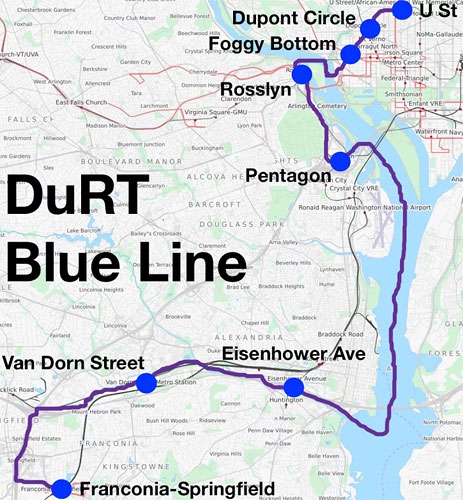Who needs Metro? Duck Rapid Transit is the answer to the Blue Line crunch
This article was posted as an April Fool’s joke.
Metro’s total shutdown earlier this month forced many people to travel by other means for the day. But maybe that’s just the way things should be. All the time. It would be much cheaper to get around using existing water infrastructure if the region built Duck Rapid Transit (DuRT).

Concept rendering of a possible Washington-area DuRT line from the from the Institute for Tub and Duck Policy (ITDP). Base duck photo by Jonathan Chen.
DuRT would be perfect for the Washington region, especially the overburdened Blue Line. With minimal investment, passengers could ride aboard a high-speed fleet of DC Duck Tours’ amphibious boat/bus vehicles, running primarily on the Potomac River but also on dedicated Duck Occupancy/Toll (DOT) lanes in both Virginia and DC. Travel times would be competitive with Metro.
“Why isn’t now the time to ask whether we should keep investing in the Metro system?” asked Thomas O. T. B. Fired, a senior fellow at the Maryland Public Policy Institute. “Any reasonable metric shows it’s not a good form of transit compared to other ones.”
If Fired had his way, he said he would close Metro. He was previously quoted by the Washington Post’s Kendrick Bunkle saying he’d fill in the tunnels with dirt, but we now know Bunkle misheard him and he really meant DuRT.
Here’s one possible transit line alignment, with stops at eight existing Metro stations: Franconia-Springfield, Van Dorn Street, Eisenhower Avenue, Pentagon, Rosslyn, Foggy Bottom-GWU, Dupont Circle, and U Street. A future stop could also be added at the Watergate complex.

The idea garners mixed reviews
The Georgetown Business Improvement District, which spearheaded a study of a gondola from Rosslyn, is eager to see an analysis. “I just want a feasibility study of DuRT,” said BID director Stone Jerlieb. However, some residents immediately inveigled against the idea on the local listserv. In response to counter-arguments that this is far in the future, local neighborhood curmudgeon, Ima Ghenstytt, said she had to be opposed “just to be sure.”
It’s also unclear if Georgetown could even get a DuRT stop, but the BID isn’t worried. “The line for Georgetown Cupcake starts in Foggy Bottom, anyway,” said Bill Footsfield, BID Coordination Coordinator.
In addition to new Duck Loops at each of the stations, the route would require the construction of ramps to connect dedicated lanes along existing roads like I-95, Virginia 110, and New Hampshire Avenue to waterways like Backlick Run, Cameron Run, and the Potomac River, including a funicular ramp near Key Bridge.
Local transportation innovator Gabe Gross also roundly applauded the idea, saying, “This is a bold step towards having fully accountable public-private partnerships operate all of America’s transit. Also, having more transportation options improves the region’s resilience in the face of imminent disasters, like floods and electrical cable insulation.”
DC Ducks could receive the same fares and public subsidy levels that the Blue Line currently receives, but DuRT operating costs would be lower than Metrorail, since the vehicles can be powered primarily by stale bread crumbs.
The DC government actually considered DuRT under former DDOT head Tan “Danger” Lini. That concept would have further extended the line to Columbia Heights by making the Meridian Hill Park fountain into a log flume. But that plan foundered after the National Park Service told DC it would require a public EIS process that would conclude, at the earliest, on April 1, 2036.
Some park advocates also opposed the idea at the time. Referring to the alignment near the Watergate, Ivana Park, co-chair of the Committee to Re-Engineer Extant Plans (CREEP), said, “The 1930 landscape plan for this area does not show the canal being used for boat transportation, so this use would plainly violate the historic nature of the C&O National Historical Park.”
Will people ride it?
A major criticism of DuRT nationwide is whether riding on a duck boat carries a stigma as compared to more upscale-seeming vehicles. For that reason, some cities have tried using swan boats instead.
Miami politicians recently asked to replace a duck project, long in planning, to swans. “People don’t like to take ducks,” said Miami-Dade Commissioner Xavier Suarez, “unless they have no alternative.”
But proponents like Yorick Yoffe of Citylab argue that these are myths, and if a good-quality DuRT line were built, people would ride it.
The US has not successfully built a DuRT line without it devolving to a bathtub-sized project through “DuRTy Creep,” but proponents hope a Backlick Run/Potomac River line could be the one that finally succeeds.
